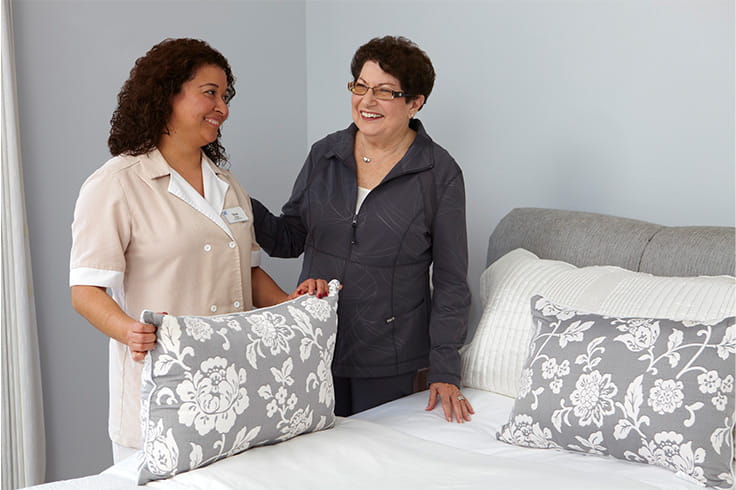According to Genworth’s Cost of Care Survey, the national median cost of assisted living (for a private single room) was $4,300 per month in 2020. But look closer, and you’ll see that costs can vary based on a number of factors.
Let’s take a look at what can affect the cost of assisted living.

Location
Think about what it costs to live in a high-rise in the big city, a ranch in the Midwestern suburbs, or even a farm on a dirt road. Predictably, one of the biggest indicators of cost is geographic location — thanks to real estate prices, employee wage trends, and the various costs of providing care in each area.
According to Genworth’s survey, median monthly costs in 2020 ranged from $3,000 in Missouri to more than $6,800 in parts of California.

Levels of care and ancillary services
What you pay for assisted living will depend on how much care you need. Every assisted living facility offers assistance with basic activities of daily living (ADLs). But most states haven’t standardized levels of care, so it’s up to individual assisted living facilities to define them.
When considering assisted living, it’s also important understand what services and amenities are included in the monthly fees. Any facility you’re considering should be up front about all the services and amenities that are included with the monthly fee — and what’s not included.

Other factors affecting cost
There are many factors in play when determining costs, including:
- Facility rating
- Staff qualifications and tenure
- Size of accommodations, and whether it’s private or shared
- Level of luxury
- Included amenities
- Labor supply and demand
- Other costs for medical care and supplies
The cost of assisted living continues to increase over time.
In 2004, when Genworth began tracking assisted living costs, the median monthly cost of assisted living care in the United States was $2,400.
Today, the median monthly cost is $4,300.
COVID-19 has also contributed to an uptick in costs. Genworth’s research shows these rate increases have been caused by labor shortages, wage demands, more stringent CDC requirements, and more.
If history is any indication, costs will continue to steadily increase.
For those looking to make a plan for care and better financial predictability, a Continuing Care Retirement Community may be the answer. In Inclusive (Type A) CCRCs, residents pay a higher entrance fee but can access the entire continuum of care for one monthly fee.
Independent living
Assisted living residents require assistance with activities of daily living (ADLs), so these facilities are generally pricier than independent living because of the level of care they provide.
Skilled nursing
Just as assisted living is more expensive than independent living, skilled nursing facilities are more expensive than assisted living — again, because of the higher level of care they provide to their residents.
CCRCs
In Inclusive CCRCs, residents who later need assisted living can access that care for little to no increase in their monthly fee. In Fee-for-Service CCRCs, you will have access to care, but you’ll pay for it at current market rates.
In-home healthcare is also an option for seniors interested in aging in place at home.
Costs for these services vary by the usual factors — particularly geographic location — as well as the number of hours of care required each month.
According to Genworth’s 2020 Cost of Care survey, the monthly median cost for an in-home health aide providing eight hours of care per day, five days a week, was $4,160.
For seniors requiring around-the-clock in-home healthcare, the monthly median cost skyrocketed to $17,472.
Most Vi communities are Inclusive (Type A) CCRCs, which means care costs are included in the monthly fee, regardless of where you are on the continuum of care. That means that these residents would continue to pay the same monthly fee after moving to the care center.
At Vi, as with many other communities, monthly fees increase annually, but a resident’s monthly fee still won’t change if they need to move to a higher level of care.

Some Vi Communities operate with a Fee-for-Service (Type C) model. Under that model, residents have access to the care they need, but monthly fees will increase based on standard market rates for the care services required.
Costs for couples living between independent living and the care center
If one member of a married couple living at Vi requires a higher level of care, their spouse can remain in independent living while the other moves to our care center.
If the couple has chosen an Inclusive (Type A) CCRC contract, they will pay only independent living monthly fees — there is no increase in monthly fees for the spouse who moves to the care center, with the exception of fees for ancillary items, extra meals, etc.
For couples on a Fee-for-Service contract, the monthly fee will increase to reflect standard market rates for the higher level of care.
Services and amenities for additional costs
- Physical, speech and occupational therapy
- Ancillary medical supplies and services
- Pharmaceutical services
- Personal aide services
- Personal transportation
- Personal laundry service and dry cleaning
- Salon and barbershop services
- Guest meals

Vi’s team is always available to answer your questions about assisted living costs and CCRC costs — even if you don’t ultimately choose to move into a Vi community.
Glad to be connected!
There’s a lot to consider when embarking on the next phase of retirement—and contacting us is a big step. (Well done!)
We’ll be in touch soon to share expert insights and resident perspectives that we hope are helpful, and one of our team members will also be reaching out to answer any questions you may have.
